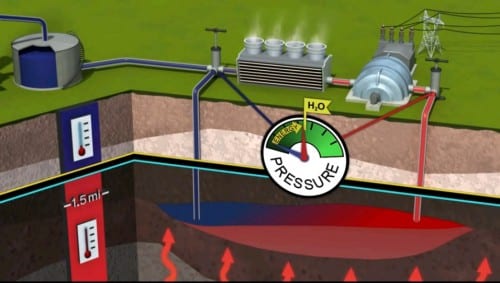The design of the new power plant resembles a combination between a typical geothermal power plant and a particle accelerator of the Large Hadron Collider type

Researchers are developing a new type of geothermal power plant that will utilize the carbon dioxide material that lies underground - and use it as a means of optimizing the production of electrical energy tenfold compared to existing geothermal energy approaches.
The technology that implements this capability already exists in various industries, so the researchers are optimistic that their new approach could expand the use of geothermal energy in the US beyond the few states that currently utilize it. The research team presented an expanded version of the technology, along with a computer-animated video explaining the importance of energy production technologies for climate change management, at a meeting of the American Geophysical Union in December.
The design of the new power plant is similar to a combination of a typical geothermal power plant and a Large Hadron Collider particle accelerator: it includes a series of concentric rings with horizontal walls deep underground. Inside these rings, materials such as carbon dioxide, nitrogen, and water, swirl separately in order to flow heat from the layers below the surface of the ground up toward the surface, where this heat is used to operate turbines and generate electricity.
"Typical geothermal power plants are fed by hot water located deep below the surface of the ground by absorbing the heat contained in the hot water, use it to generate electricity and in the next step return the cold water to the subsoil in the depths. In the new design, the water is replaced, in part, with a carbon dioxide-type substance or another liquid - or combinations of several liquids," explains the lead researcher. He adds that carbon dioxide conducts heat more efficiently than water. The new method may be up to twice as effective as existing methods, according to computer simulations.
"When we started developing the idea of using carbon dioxide to produce geothermal energy, we wanted to find a way to make the storage of this material economical while expanding the utilization of geothermal energy," explains one of the researchers. "We hope that we can expand the use of geothermal energy in the US so that it includes most of the states west of the Mississippi River," says the researcher. The researchers believe that their new design could allow geothermal power plants to store energy - at the rate of hundreds of gigawatt-hours - for days and even months, energy that could be available to consumers when the rest of the normal electricity grid faces higher than usual demands. The geothermal formation in the underground will be able to store heat and compressed gases (carbon dioxide and nitrogen), and release this heat to the power plant located on the ground when the demand for electricity is high. The station will also be able to suspend the extraction of heat from the underground during times of low electricity demand, or when energy from other renewable sources (solar or wind) is already flowing into the electricity grid.
"What makes our idea revolutionary lies in the fact that we can deliver renewable energy to consumers at the time of demand, and not depend on the times when the wind blows or when the melting snow creates the most powerful water flows," explains the main researcher. In the computer simulations, a 10-mile-wide system of concertina rings with horizontal walls located about three miles underground produces half a gigawatt of electrical energy - an amount equal to the amount produced by a medium-sized coal-fired power plant - and ten times the amount of 38 megawatts produced by an average geothermal station in the US. The simulations also showed that a station with such a design could capture an amount of 15 million tons of carbon dioxide every year, an amount equal to the amount produced by three medium-sized power plants powered by coal.
The researchers expect that the use of this type of energy will expand to other states besides California and Nevada, where the warm water is relatively close to the surface. However, the new design is much more efficient both in terms of energy storage capacity and in terms of heat flow so that even smaller "hot spots" in areas of the western US can generate electricity. The eastern US is largely devoid of even small hot spots, so the production of geothermal energy in this region will still be limited to a small number of particularly active areas, for example West Virginia, the researcher notes.
Another point that will need to be addressed - the geothermal station will have to be connected, most likely, to an abundant source of carbon dioxide, for example - a power plant that operates on coal and which emits this gas from its chimneys. This connection could exist through a pipeline, for example.
On the other hand, explains the lead researcher, the study showed that this design could work effectively even without carbon dioxide, and said that a pilot plant based on this design, which was operated with the help of nitrogen injection only, proved economic feasibility. The research team is currently working on more detailed computer model simulations and more accurate economic analyzes for defined geological formations across the US.
News about the eraserר

One response
As in Patrick Khodi Khodi's song...search on you tube